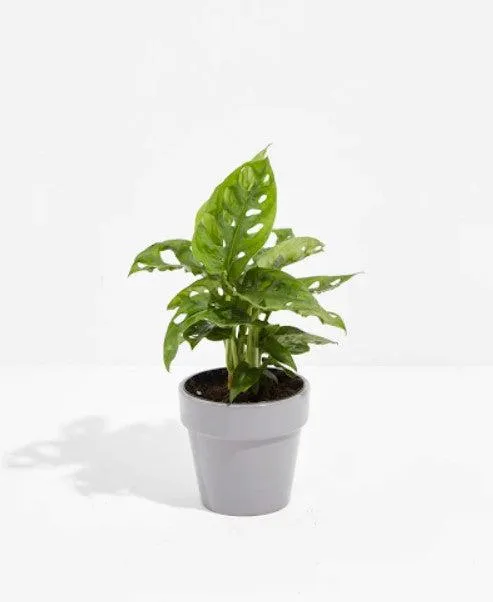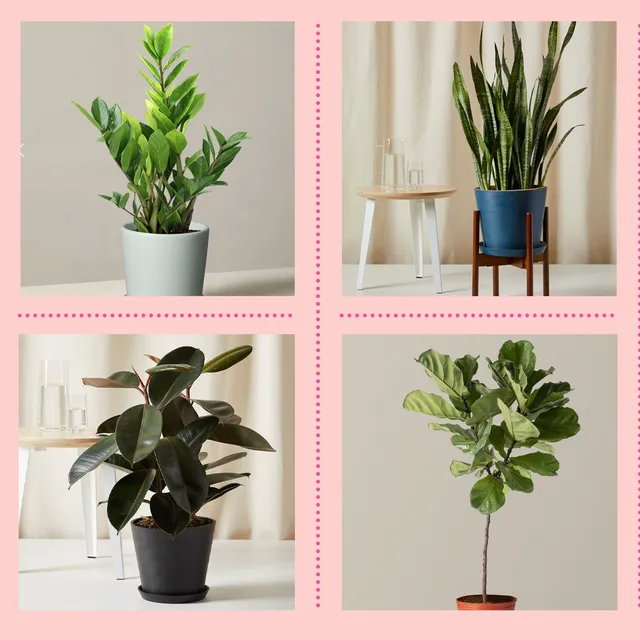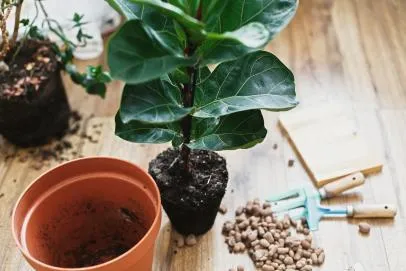The Best Large Leaved Houseplants to Beautify Your Home
If you’re looking to add some lush greenery to your indoor spaces but want leaves bigger than your average pothos, read on for recommendations of some of the top large leaved houseplants. From palms to philodendrons, these big leaf beauties will surely make a statement without skimping on care requirements.
Chinese Money Plant (Pilea peperomioides)
The Chinese money plant, also called the pancake plant, is trendy right now for its adorable coin-shaped leaves. What buyers may not realize is just how huge these leaves can get with the right care. While starter plants come with leaves around 1-2 inches across, a mature money plant can have leaves up to 5 inches wide. Give it plenty of sunlight and well-draining soil, and it will reward you with a cascading effect of enormous shiny rounds. I have one hanging in a southwest window that seems to get bigger every day!
Monstera Deliciosa (Monstera deliciosa)
No list of large-leaf houseplants would be complete without mentioning the monstera. Often called the Swiss cheese plant for its iconic perforated leaves, mature specimens boast single lobed fronds up to 2 feet long. But it’s a commitment—these beauties are slow growing and need support as they climb. The rewards are leaves that look like they were cut from the jungle floor. They’re also popular due to their association with indoor tropical decor seen on Instagram. Just be prepared to give yours several years to get truly monstrous!
Fiddle Leaf Fig (Ficus lyrata)
For truly statement-making foliage, a large fiddle leaf fig tree is hard to beat. These petite trees support leaves up to 2 feet long on a robust trunk. They need lots of sun and infrequent watering once established. A word of caution though—their leaves drop dramatically with any changes to environment or care. I lost over half the leaves on mine after relocating it just 5 feet away from its original spot! Figs perform best in consistent conditions. But when happy, their broad, glossy leaves create a striking tropical accent.
Rubber Plant (Ficus elastica)
Rubber plants, or rubber trees, have an air of retro charm with their thick, glossy leaves. Mature specimens approach 3 feet tall sporting leaves around 10 inches long. Not only are their dimensions impressive, but rubber plants are virtually indestructible. They thrive on neglect, only sipping water occasionally. Propagation from cuttings is kind of a no-brainer too— basically just stick a leaf stem in water and watch it take root! Their hardiness makes them a great option if you lack a green thumb. Just give them bright light and don’t overwater.

Philodendron (Philodendron species)
There are countless varieties of philodendron with leaves ranging from 6 inches to over 2 feet long. Two top picks for large foliage are P. gloriosum with heart-shaped leaves up to 24 inches, and P. bipinnatifidum, also called the selling point philodendron, offering deeply lobed leaves around 10-15 inches. Like monstera, philodendrons are climbing vines that appreciate moss poles or structures to weave through. They’re tolerant of low light and make excellent hanging basket plants. With patience, they develop into lush foliage specimens within a few years. You’ll want to provide consistent moisture and fertilizer to get philo leaves in the biggest size range.
Palms (various genera)
For the ultimate large leaf, look no further than palms. Choices include feather duster palm with fans up to 6 feet long, bamboo palm with broad semi-circular leaves reaching 5 feet, and lady palm with gracefully arching fronds 3-4 feet long. Palms prefer bright light and humidity. But perhaps their biggest selling point is their ability to thrive in low-maintenance conditions. Many palms are happy with just occasional watering. Their stately form and striking foliage make them top contenders for adding tropical elegance to any space. Even large palms stay quite manageable as houseplants.
Other Considerations for Large Leaf Plants
While the above recommendations offer impressive leaf sizes, it’s important to also factor in other characteristics like their needs for care. Here are some additional things to weigh:
- Light requirements: Money plants and palms handle lower light best. Figs, monsteras, and philodendrons need the brightest conditions you can provide.
- Watering: Money plants, palms, and rubber plants are the most forgiving if you forget to water occasionally. Figs and monsteras need regular moisture but not too soggy soil.
- Fertilizer: All plants will produce larger leaves with balanced fertilizer in the growing season, but figs, monsteras, and philodendrons especially utilize the nutrients.
- Pruning: Monsteras and philodendrons may need pruning to control size and shape if allowed to vine. Rubber plants and palms don’t require any pruning.
- Pests: Figs, monsteras and philodendrons are prone to spider mites or mealybugs if conditions aren’t ideal. Rubber plants and palms tend to be quite pest-resistant.
Another thing to keep in mind is available space. Mature palms and monsteras take up more horizontal real estate than vining philodendrons do. Money plants, meanwhile, can be grown in small containers very successfully even when the leaves get big.
My Top Two Picks
If I had to recommend only two large leaf plants to start with, I’d go with Chinese money plant and rubber tree. They offer impressive leaf sizes together with resilience to survive erratic watering schedules. Both propagate easily too if you want more! The money plant’s compact form also works well in smaller spaces. While other choices look more “jungle-like”, these two get the job done without high maintenance demands.

Common Problems and Solutions
No matter how durable a plant’s reputation, issues can still arise. Here are some potential problems large leaved houseplants may face and suggested solutions:
- Brown Leaf Tips: Could be from mineral buildup in hard water. Flush pot well with water and use rainwater or filtered water going forward.
- Yellowing Leaves: Potential causes are over or under watering, low humidity, or lack of nutrients. Check soil moisture and Environment. Increase humidity and fertilize in spring.
- Leaf Drop: May mean the plant wants more light. Move to a sunnier spot gradually. Or it could signal overwatering—let soil dry more between waterings.
- Spider Mites: Quarantine plant and wipe leaves with soapy water. Spray weekly with neem oil to control infestations.
- Mealybugs: Isolate plant and rub bugs off with cotton swab dipped in rubbing alcohol. Spray top and bottom leaves weekly to manage—these suckers love figs and monsteras!
With some basic care adjustments, you can bounce your leafy beauties back to health in no time. Don’t lose hope if an issue arises—even us seasoned plant parents mess up sometimes! Large leaves make forgiving houseplants overall.
In conclusion, large leaved plants are a gorgeous way to bring the outdoors in without skimping on size. While they do demand some special considerations, many offer remarkable resilience to survive occasional lapses in watering, pruning, or pest management. Start with one of the hardier options like Chinese money plant or rubber tree, give it conditions to thrive, and you’ll surely be rewarded with foliage to impress all your plant-loving friends. With a little TLC, you’ll feel like you’ve got your own lush tropical jungle hideaway indoors. Happy planting!
Large Leaved House Plant Care and Considerations
| Plant | Average Leaf Size | Light Needs | Watering | Humidity | Special Care |
|---|---|---|---|---|---|
| Dieffenbachia | 6-12 inches | Medium light | Allow soil to dry slightly between waterings | Moderate | Poisonous if eaten, keep out of reach of children and pets |
| Monstera deliciosa | 6-20 inches | Bright indirect light | Water when top inch of soil is dry | Moderate | Support vines as it climbs |
| Philodendron | 4-12 inches | Low to medium light | Water when top inch of soil is dry | Moderate | Toxic to pets if eaten, keep out of reach |
| Chinese Evergreen | 4-8 inches | Low to medium light | Water when top inch of soil is almost dry | Moderate | Tolerates low light, prune to maintain shape |
| Rubber Plant | 6-12 inches | Medium light | Water when top inch of soil is dry | Moderate | Toxic to pets, keep out of reach |
FAQ
-
What types of large leaved house plants are popular?
Some of the most common big leafy plants that people keep indoors are peace lilies, monsteras, philodendrons, Chinese evergreens, and ficus trees. They can add a neat jungle vibe to any room!
-
How often do they need water?
Most big leafy plants will want water when the top inch or two of soil feels dry. But you gotta check the soil instead of just watering on a schedule. Some guys may need a drink every week while others could go every couple weeks. It basically depends on the plant variety and conditions.

-
What kind of light do they prefer?
Many large-leafed houseplants dig bright, indirect sunlight. Places next to an east- or west-facing window are prime real estate. However, certain types can handle low light a bit better. You gotta do your research to pick one that will be happy in the light you got.
-
How do you keep them looking their best?
Occasional misting helps some varieties look stunning. You can also gently wipe down foliage with a damp clothnow and then to dust. Be careful of over-fertilizing. Too many bottles may harm more than help! Stake tall ones if they start to droop heavily. With a little TLC, these beauties will really shine.
-
Are they toxic to pets?
Sadly, many large leafy plants are poisonous to cats and dogs if nibbled. The ASPCA has a nice list online of unsafe flora if you’ve got furry friends around. It might be better to choose pet-proof picks or put tempting types up high. We don’t want any pets getting sick!
-
What problems might they have?
Pests and diseases can plague houseplants now and then. Check closely for signs of bugs. Isolate and remove any leaves with yellow or brown spots too. Under- or over-watering may cause crispy brown edges also. Be on the lookout early before trouble gets outta hand. A little prevention beats costly treatment down the road.
-
Any tips for displaying them artistically?
Groupings can look amazingly stunning. Mix and match textures for visual interest. Hang some pots from above or train vines onto poles. You could even make a living wall! With some imagination, these beauties become real interior decor elements. Who needs extra artwork when plants themselves are works of natural art?

